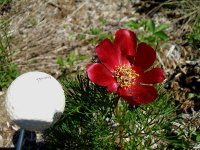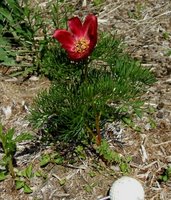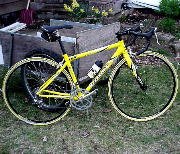 This species is always a visitor-stopper when in flower and often even when it isn't, despite the fact that it isn't really suited to the wet maritime climate at my place and so never achieves the vigour that it shows further west in Canada. It's not easy to find, and my first plant purchased
This species is always a visitor-stopper when in flower and often even when it isn't, despite the fact that it isn't really suited to the wet maritime climate at my place and so never achieves the vigour that it shows further west in Canada. It's not easy to find, and my first plant purchased  some 12 years ago has turned out probably to be a hybrid (second and third photos). A few years later I was given a piece of the proper thing (first and third photos) and more recently have been getting results from purchased seed. The first of the seedling batches, a dwarf form called subsp lithophila, has started flowering this
some 12 years ago has turned out probably to be a hybrid (second and third photos). A few years later I was given a piece of the proper thing (first and third photos) and more recently have been getting results from purchased seed. The first of the seedling batches, a dwarf form called subsp lithophila, has started flowering this  year (fourth photo onwards).
year (fourth photo onwards).The flowers are blood red with a striking eye of yellow anthers. First bloom here in my datum bed (part shade) was 31 May this year, although plants in the open field were two days earlier
 and my older plants in a more exposed position were another 2 days ahead.
and my older plants in a more exposed position were another 2 days ahead.Foliage is very finely divided (less so in the hybrid which is the plant further from the camera in the third photo) and outstandingly so. Plants grow to 1-2 feet tall, perhaps half that in subsp lithophila. Here, perhaps due to

 the wetter climate, it can tend to be a bit recumbent (eg 5th photo) but normally stems should stand upright. It's only fault is that it is the one peony most likely to go dormant in late summer in hotter and drier locations. I'm usually spared from that though.
the wetter climate, it can tend to be a bit recumbent (eg 5th photo) but normally stems should stand upright. It's only fault is that it is the one peony most likely to go dormant in late summer in hotter and drier locations. I'm usually spared from that though. New growth usually appears quite early, but are not bothered by snowfalls that come later to cover them. Young shoots look rather like something out of a Dr. Seuss book, and at that stage it is easy to see that this peony tends to form a spreading colony rather than the tight clump most other peonies grow as. When happy it can grow to carpet an area several metres across.
New growth usually appears quite early, but are not bothered by snowfalls that come later to cover them. Young shoots look rather like something out of a Dr. Seuss book, and at that stage it is easy to see that this peony tends to form a spreading colony rather than the tight clump most other peonies grow as. When happy it can grow to carpet an area several metres across.P tenuifolia is native to southeastern Europe, from Yugoslavia into Russia, the Crimea, the Ukraine, Turkey and the Caucasus. It grows mainly in dry grassy areas, although also occuring in open woodlands, and enjoys a bit of limestone in the neighborhood.
Here, it lacks vigour in my woodland bed (definitely pushing the envelope!) and is best with as much sun as it can get. Care needs to be taken here over its drainage. It does much better in the colder prairies of Canada than it will ever do for me, but it is worth the effort of proper siteing to have even a small clump of it.

1 comment:
I love the little purplish tufts. They look to me like "Sea Anemones", except clearly on dry land. Beautiful flowers, and nice foliage. One I can only dream about, unfortunately. Although you are right to say it likes more open country than the others, it just seems to shrivel in hot winds, Down Under. At least that is my experience.
At least I can enjoy your photos.
Denis
Post a Comment